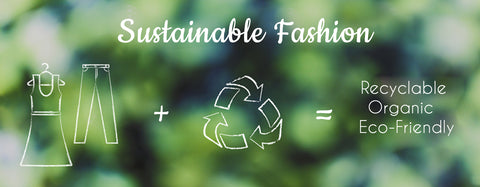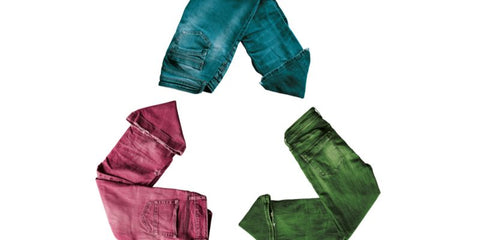Sustainable Fashion By Recycling Vintage Fabrics

We hear enough of sustainable development now and then, and often talk about minimizing the carbon emissions and water waste. But did you know about one of the biggest contributors to environmental depletion?
Fashion is one of the fastest sectors of the economy which has ignored its environmental implication for a good long period. But not anymore! With the rise in awareness about the environment, the concept of Sustainable Fashion has come up.
Sustainable fashion is about a mindful shift in one’s fashion preferences. It is about meeting the demands of the present without compromising the needs of the future. People in the 21st Century thankfully have started to accept the responsibility they have towards the environment.
In this article, we are going to talk about an important environmental concern that bears the mask of Fashion.
Why Sustainable Fashion?
With the growth of industrial activities, there also is seen an increased level of pollution and resource scarcity. Fashion, the fast fashion to be precise is being one of the largest contributors in the degrading environment. Textile production consumes a lot of natural and man-made resources. The production of one kilogram of cotton, for instance, uses approximately 10000 liters of water. On the other hand, petroleum-based products like polyester ingest a lot of non-renewable resources. The consumption of these resources is not the only problem, the concern is also about the waste that arises out of this production. And that’s huge!
If we look back to the first half of the 20th Century, we would find how simple attire choices were back then. However, the production of these fabrics involved more of hand labor which made it a time-consuming process. The quality of apparels was fine during those days because every piece was being handspun by small farmers and laborers. But as the demand for textiles increased, technology started to come into the picture. The introduction of technology into textiles eventually led to mass production by industries. Production at a large scale though did help economically, but it wasn’t going green at all. To prevent the clothes from wrinkling and shrinking, the manufacturing companies started adding chemicals into the production.
With improvements in technology, the petroleum-based clothing came into existence. This further led to the production of hazardous synthetic fibers which is now degrading the environment at an alarming rate.
We need to understand the kind of impact these synthetic fabrics are leaving on our environment. Though these fabrics do come with prima facie easy handling and cheap prices, there lies a huge cost beneath that comfort. Synthetic fabrics like polyester and nylon are by-products of petroleum and are non- biodegradable by nature. This means that these fabrics not only consume a lot of resources but also do not decompose easily and accumulate landfills.
On the other hand, fabrics like viscose and Rayon are made up of wood pulp and are processed with chemicals. Though the disposal of these fabrics is not as harmful as other synthetic fabrics, it causes enough destruction in the form of deforestation.
Billions of garments are produced every year and are being stocked up inside homes and warehouses but for how long. What about its disposal? How do you dispose of the clothes that are no more going to be used? The generation today is going gaga over being trendy and the trends in the fashion industry are short-lived. What happens when apparels go out of trend? They lead to landfills, environmental deterioration, and health hazards which is why they are to be controlled immediately.
Upcycled Fashion and its Contribution

One way of contributing to Sustainable Fashion is by accommodating Upcycled Fashion into one’s lifestyle. Upcycled fashion is a process to make an item better than its earlier version. We, at Sanskriti India, are adopting upcycled fashion by recycling vintage fabric into fashionable dresses, scarves, etc. Vintage fabrics are in great demand by craftsmen. They use vintage sarees for their projects. Also, with an increase in awareness about the environment, people are getting more thoughtful about their fashion choices. Working women these days are making a shift from synthetic fabrics to quality handwoven fabrics like cotton and silk.
Adopting Vintage in your lifestyle not only does good to the environment but also helps in keeping the culture alive. Vintage is a symbol of history, quality, and tradition. By giving it a modern twist through upcycling we are not only being fashionable but standing out with the goodness of the forgone age. Nevertheless, reviving life into an old piece of cloth is super cool and creative.
Our Commitment to Sustainable Fashion
We have been dealing in vintage pure silk sarees for 10 years now, and throughout our journey, we have come across several like-minded designers and craftsmen who share our vision of playing responsibly with business. Not only did this keep us going but also inspired creativity at every milestone that we passed and the feedback that we received in the process.
We value quality before anything and to ensure that we do it right, we undertake the required tests to keep it in check. We have a set up for Burn Tests to check the purity of the fabrics before it is offered to our customers. For those of you who are unknown to burn tests, here follows a little piece of acquaintance.
A burn test is done by putting a piece of fabric on the flame. It is usually undertaken to identify the fiber composition of unknown fabrics by designers and manufacturers. The identification is done by observing the flames, examining the fumes and ashes that remain.
By conducting such tests, we make sure that we offer only the best quality to our customers. Also, it gets easier for them to trust that they are going sustainable with their purchases.
Adherence to Sustainable Fashion
If we go down a little deeper, we realize that sustainable fashion is more than just the choice of fabrics. It indeed is about coming together and benefiting people involved throughout the supply chain, from farmers to the end-users and also the people who are involved in the recycling processes.
Simple ways by which one can contribute to sustainable fashion are as follows
1. Education and awareness
Going sustainable does not mean you have to quit fashion. It rather calls out for informed steps towards fashion. It is about educating oneself about fabrics and their production processes to choose thoughtfully. It is always a best practice to examine a brand’s production process before making a purchase. Awareness is the light we all need to reach out to a healthier environment.
2. Adopting Vintage Fashion
Bringing vintage to your wardrobe has several benefits to offer. It saves you a lot of money and yet promises the best quality. The production process in the old times was much simpler and eco-friendly. By making a space for the vintage, You not only revive a forgone culture but also earn a chance to stand out and establish a fashion statement.
3. Shed off Fast Fashion
With the fashion industry evolving swiftly, it is tempting to buy cheap fast fashion. However, this is where the change should begin. Rather than filling up your cupboard with a number of cheap quality clothes, it is better to invest in a few quality products. This is one way of discouraging the hazardous production of short-living fashion. Mother earth will thank you for this win over.
4. Spreading Awareness
The first step towards solving a problem begins with the identification of the problem. Not everyone is aware of the impact their fashion choices are making. But if they are educated about it, they are less likely to be ignorant. So, now that you know how fashion choices are affecting the environment, it is time for you to spread the word.
The true power of making this movement successful lies in the hands of the ultimate consumers. And we are all ultimate consumers. Fashion is for everyone but Sustainable Fashion is a choice .and we can reach closer with every committed step. We often forget the power of a drop in the ocean until we have none left. Do not let that happen to your Earth. Commit to begin Now, and secure the generations to come.
